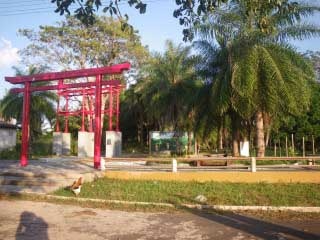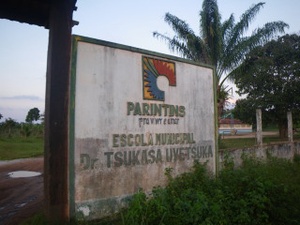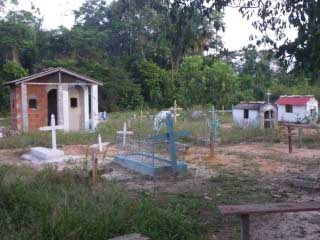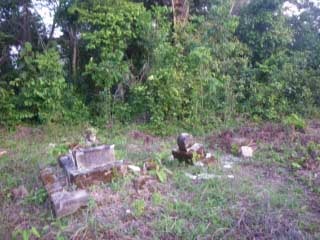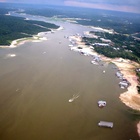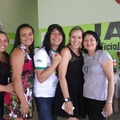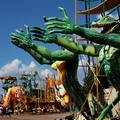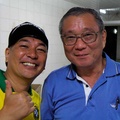August 12, 2010.
"Since you've come all the way from Japan, you should first check out Villa Amazonia."
When I first visited Parintins with a JICA coordinator, I had the opportunity to visit Vila Amazonia, arranged by the vice-mayor at the time. Vila Amazonia is a settlement where Takataku (a graduate of the Japanese Higher Takushoku School) and his family once lived and ran the Amazonia Industrial Research Institute. They were known as the Japanese who successfully cultivated jute in the Amazon jungle, and the building that was their base, the Hakko Kaikan, was said to be a truly magnificent shrine-like structure. Before we departed, Mario Taketomi Parintins, then president of the Japan-Brazil Association, gave us a detailed explanation, showing us old documents.
We boarded a small boat with a capacity of about 10 people from the port of Parintins and traveled down the Amazon River for about an hour. Our destination came into view on the opposite bank. Shabby wooden houses were lined up here and there in the jungle. This was the port of Villa Amazonia. There was only one wooden shack-like shop at the port. There was no supermarket to buy daily necessities, and the only other facilities were a church and a school.
After walking about 100 meters from the port, a field came into view. A 4-meter-long wooden pole has the word "Hakko-Kaikan" written on it. Where the "Hakko-Kaikan" once stood, only the foundations of the building remain. A few dozen meters away, in a square called Praça, there is a large red torii gate representing Japan, a monument modeling jute cultivation, and a bust of Ryota Oyama, the father of jute. The exposed steel framework of the waterworks can be seen. It is said that there used to be a hospital here. Almost no houses where Japanese people lived at the time remain. One of the remaining ones was inhabited by local Brazilians.
Mario said.
"Now, let's take a mototaxi to the school and the cemetery before it gets dark!"
It was hard to find a motorcycle taxi (mototaxi) because it was a small town. Mario, who was a little overweight, got into one, and I and the coordinator squeezed into the other. I never thought that we would be riding three people on a motorbike in the Amazon jungle.
First, we arrived at the "Uekusatsuka School," named after Takataku's father, Tsukasa Uekusatsuka. In honor of the achievements of Japanese people in the Amazon, many schools, hospitals, and buildings are named after Japanese people in and around Parintins. Mario seemed to be busy explaining something to the school staff about the commemorative ceremony for Takataku's 80th anniversary.
The two moto-taxis went deeper into the jungle. The road changed from a paved road to a dusty dirt road, and then to a bumpy animal trail overgrown with weeds. We continued on the pathless road and climbed a hill, where we came across a small cemetery. It must have belonged to a local. There was a simple handmade wooden graveyard. It was colorful, as is typical of Brazilian graveyards, but it was also painful to look at. There were many rotting crosses that looked like they were about to collapse. And beyond that was a wasteland with broken stone slabs and concrete blocks scattered among the overgrown grass.
"Toshimi, look. This is Takataku's graveyard."
"Yeah? Why is it so cruel?"
This wasteland is the grave of people who lost their lives here 70 or 80 years ago. During and after the war, the local Japanese had their language, property, and land confiscated. There was a rumor that Japanese people put their property in their graves after they died, and they were subject to a lot of grave robbing. There is also a story that the grave markers that were broken after the robberies were used by poor local people as foundations for their own graves. It's a ridiculous story that makes me sad. Young people who came from Japan with big dreams and hopes. And some of them had families that were called here and got married here. In the thick grass, the graves were left in a miserable state without retaining their original shape. On this day, I could only identify two stone slabs as gravestones. On one of the gravestones, a Japanese family name and the numbers 1939/9/4-1940/2/18 were written. It belonged to a child who was thought to have passed away within a year of being born.
"June 2011 will mark exactly 80 years since Takataku first came to Villa Amazonia. Before the 80th anniversary ceremony, I plan to clean up this dilapidated cemetery. If it remains like this, I will be sorry for my ancestors. The ceremony is in June. I will definitely make it a success."
Mario said emphatically.
© 2017 Toshimi Tsuruta


